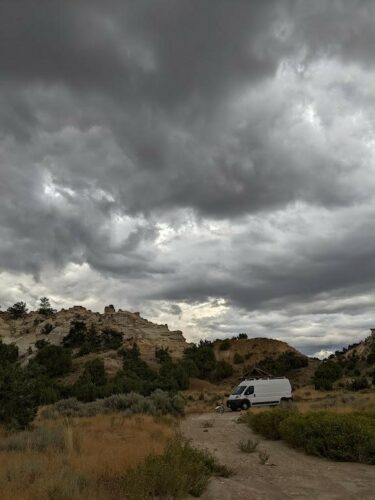Are you ready to take a journey across the Atlantic to Europe to explore a multitude of countries and cultures? All while driving through this picture-perfect landscape with your RV?
First, you need to know the lingo. In Europe, RVs are referred to as mobile homes, camper vans, or caravans. If you’ve traveled in the United States and have gawked at the massive motorhomes and 5th wheels parked near Disneyland or Yellowstone, you won’t find these behemoths in Europe. The European motorhomes are much smaller. And that’s just the start of the differences!
I traveled through Europe for a year with my family in a 1998 Fiat Hymer B35 motorhome van. We explored Germany, Switzerland, Italy, France, Andorra, Spain, and Portugal. There are some big differences between RVing in the US and in Mediterranean Europe!

Let’s cover the main differences and similarities you will find while traveling in an RV camper van in Europe!
DON’T BRING THE KITCHEN SINK!
Motorhomes in Europe don’t have much space. Everything is very compact. While the average length of an RV in the US is around 28-30 feet, in Europe, the average length of a camper is 19-23 feet! The typical Class C motorhome is about 24 feet. And 7 feet wide, not 8, is standard (12-ft-wide Interstates are rather a rarety). In fact, in most of Europe, wide-body RVs are illegal, plain and simple.
The reason is simple: European country roads are narrow, winding, and often lined with rock walls, hedges, or other structures. Remember, many of these towns are centuries old – before gridwork urban planning was a thing. You simply couldn’t navigate these charming pathways in most American RVs.

Similarly, most European RVs don’t have slides. In fact, it’s estimated only 2-3% of European RVs have slides! All the cabinets and small storage spaces need to be carefully packed and used in accordance with belongings.
GET USED TO SHORTER SHOWERS
You won’t have the luxury of taking 5-minute showers. Most RVs have a 100-litre (40-gallon) fresh water tank, and the same for the greay water.
The black tanks have been built to be portable; most are cassette toilets. You’ll rarely find a built-in tank in an RV underbelly. So you will need to carry your black water tank to the proper disposal/dump location, which can be found at almost all campgrounds.
SOLAR POWER COMES STANDARD!
Electricity is also very expensive in Europe. This has encouraged all mobile home makers to manufacture their vans with solar panels. So if you want to take a few days to go into the woods and do a wild camp, you’ll be able to do so and not worry about running out of power. The longest I went was two weeks at a beach on the southern coast of Portugal. Fortunately, I had a 750-watt solar panel installed on my van, and this was more than enough to provide adequate electricity for everything I needed.
And because most rigs are made to run off propane or 12V DC, inverters are also a rarity.
… BUT AIR CONDITIONING DOES NOT!
With the more mild climate around the Mediterranean, most RV manufacturers simply don’t install air conditioners. It’s rare to find a camper van with an A/C installed. Bring a fan!
NOT A CHAIN RESTAURANT ON EVERY CORNER
While most Americans, myself included, love to have a variety of food choices while traveling within the United States. Europe has mostly a cultural history according to food choices. These foods are the bedrock of each country, so whether you’re eating Paella in Spain, or stinky cheese and a baguette in France, you’ll find that the immediate choices are limited in comparison to the United States. I found that it is best to take your RV closer to cities if you’re in need of something more familiar to your palette. The small villages or towns that line the outskirts of cities have very little variety of food and you’ll find the more traditional dishes lining the menu.

P.S. For anyone who is vegetarian or vegan, be careful! The countries lining the Mediterranean don’t consider fish as meat.
USE PUBLIC TRANSPORTATION TO EXPLORE CITIES
While America consists of 3.8 million square miles of land and a population of 350 million, Europe consists of 4.1 million square miles and a population of 750 million. As you can see, Europe is quite compact according to land size versus population. Therefore, most places that you may want to visit will be quite cramped, meaning RV parks will be smaller. Inner cities may not have the space you are used to while traveling in American cities.
I personally have chosen to stick to the outside of cities while traveling in Europe, since traffic impedes my ability to enter the inner city RV parks. As Europe has developed an incredible public transport system, I would encourage you to park outside of a desirable city and take the train or bus into the city for a day trip. This will limit your need to find parking and save you time.
SAFETY IS YOUR RESPONSIBILITY
I would like to think that the United States is relatively safe from robberies according to van travel. With the determination of the American police force to keep everyone safe, you might not be thinking “Do I need to park near a police station for the night?” In fact, theft and other crime at RV parks is incredibly rare in the U.S.
In Europe, the police seem to be less interested in theft prevention. While I was traveling close to Barcelona, my RV was broken into at 2:00 pm on a public boardwalk while I was swimming in the ocean. I came back to my camper after it had been emptied and the window broken. I have no doubt that people saw what was happening but chose to do nothing!
Later, I went to the national police station. They refused to file a police report as this would damage their statistics of a “safe vacation spot.” I was told to leave the police station and not pursue it further. After sharing my story with many other motorhome enthusiasts and fellow travelers, this was a common experience. Within the RV community, people had come up with great tricks to prevent similar break-ins:
1. Imaginary Dogs
A motion sensor near the van door that when activated, creates the sound of a dog barking in the van. For added completion of this trick, people would attach a dog leash and a big food bowl outside the van to complete the facade.
2. Use Police Presence
Park right outside police stations if you plan to leave your RV for a day trip.
3. Install an Alarm System
Buy an alarm kit. I use one as it’s a motion and vibration sensor for the windows and doors. It’s inexpensive and will work as a deterrent. Here’s a list of other personal safety essentials for van life on the road.
4. Travel in Groups
Find some traveling buddies and team up! Maybe work out a system where someone stays with the vans while the others do activities.
5. Buying Food
Most break-ins that I heard about happened at shopping centers. Always make sure that someone stays with the van while the other person does the shopping.
6. Chains
(This is a bit more extreme.) I met a man who had been robbed three times. He opted to chain all of his doors shut from the inside. Go out the top window of the van and then close that with a folding bar which was then locked to the roof.
7. Be Smart
Don’t leave any backpacks, phones, or valuables in sight.
YOU’LL HEAR DOZENS OF LANGUAGES
Most Americans have grown up speaking English as their first language. This allows for fluid communication across the entire country. While traveling in Europe, there are 24 official languages, with 200 additional languages centered within specific regions. This means that you will need to be very flexible according to communicating with hand gestures and sounds.
A common misunderstanding is that everyone in Europe speaks English; this is not the case! Fortunately, Google Translate has an awesome conversation feature that will help you communicate wherever you find yourself (but it isn’t perfect!).
GETTING SERVICE AND REPAIR ISN’T STRAIGHTFORWARD
Do you know how to say “my brake pump has a hole in it and I’ve lost all braking power” in Italian? Neither do I. Although this was a real circumstance I had in Italy, I had trouble communicating this. It didn’t help that the mechanic didn’t speak English. Google decided to translate this to “My bomb broke with a hole and I’ve broken power.” (Which produced many Italian hand gestures and confusion from the mechanic.)

If you find yourself in need of a repair, do your best to show the mechanic where the problem is. You can’t always depend on Google to translate technical information correctly. Better yet, take care of all the important motorhome maintenance!
I ended up ordering the brake pump from Holland. If you do need to order a part, find a comfortable camping site and have it shipped there. That way you can park your RV and wait for the part to arrive instead of your RV being at the mechanic’s for days waiting for the part to arrive.
And if you chose to import or buy a North American RV … Lord have mercy on you! It can be weeks or months until you get the correct part!
KNOW YOUR VISA LIMITS
Europe consists of 44 countries; 26 of these make up the Schengen zone. The Schengen zone shares a common visa law. You are allowed to be within the Schengen zone for 90 days. After the 90 days, you must leave.
The other 18 countries in Europe can be visited on a separate visa. So you can travel back and forth between the Schengen area and not worry about your visa expiring. Just make sure to plan it right according to the weather. You don’t want to get stuck in Switzerland for 3 months in winter while your visa renews! (unless you’re a skier). I myself got around this by staying in Andorra for 90 days while my Schengen visa renewed itself.
BEWARE OF ROAD CONDITIONS
While most Americans are used to wide open roads that allow for the 35-foot RV, Europe has grown over hundreds of years. Roads were first constructed for old wagons and horses. As technology advanced, there was little room for road expansion as homes and buildings had already been built.
Personally, I captained a 10-ft Hymer which I found to be just small enough to squeeze through the small turns while scaling the mountains in Italy or the village roads in Spain. This means that you will need to prioritize space within your mobile home. Perhaps an extra sofa or a 30″ TV needs to be left out.
P.S. Watch out for potholes in Portugal, Spain, and Italy; they’re everywhere!
KNOW YOUR PROPANE BOTTLES AND ADAPTERS
Gas, whether you choose to use propane or butane, can be found at most grocery stores or gas stations in the United States. However, in Europe, gas bottles are only sold at gas stations.
It should also be noted that there is no central gas company in Europe, unlike the states. The United States has a few gas providers: Chevron, Shell, Exxon to name a few. Europe is filled with many companies. Why is this important? Each country in Europe has gas bottle providers. Therefore, the adapters for the gas bottles vary depending on the countries you’re traveling to.
I began my journey in Poland where the bottles required a wrench and nut to tighten the seal, like in the states. Germany is the same. However, Spain and France use different adapters. If you plan to do a multiple-country visit in Europe, it is crucial that you do research into the adapters you will need, while also remembering that the gas bottles can only be exchanged between the same company. That is to say, you can’t exchange a Repsol bottle at a Cepsa gas station (these are the most common companies in Europe).
Keep an eye on your gas levels as you will need to exchange the bottles around the borders. Spain won’t accept bottles from Germany, for example.
FUEL COSTS MORE (AND IT’S LITRES, NOT GALLONS)
The most money will be spent on fuel. On the date of writing of this article, May 4th, 2022, the cost for 1 gallon of diesel on average across Europe is about $14 USD – a whopping $14 a gallon! However, European vehicles in general are much more efficient (which is much better for the environment). Thank goodness!
By the way, Switzerland, because it uses Francs, is extremely expensive. If you plan to pass through Switzerland, fill up your tank in neighboring countries before entering. This also stands true for food costs. Try to plan ahead and do research on countries that use currencies other than the Euro.
P.S. One gallon is equal to about 3.8 liters.
A SECRET TO FINDING FREE CAMPSITES IN EUROPE
Depending on the level of luxury you desire, most well-equipped campsites will cost 10-15 Euros a night. If you really want a top-scale campsite, it will cost around 25 Euros a night.
However, there is a secret that some people may not know. Portugal and Croatia are required by law to provide campsites next to dams. Portugal has opted to provide free campsites that are well equipped with showers, water filling/dumping, and free WiFi. This is to encourage tourism. I traveled in Portugal for 5 months and never paid for a campsite! It’s a beautiful country to travel in and a great way to save money. The same stands for Croatia. Other countries in Europe may provide a free one-night stay, but it’s nothing compared to the free luxury in Portugal and Croatia.

Some great RVing apps you can use for European travel: CamperContact, Park4night, and ACSI campsites. ACSI provides a membership option with added discounts and perks.
FOOD PRICES VARY BY REGION
Dining out in southern countries is cheap (Portugal, Spain, Italy, Greece, Croatia). You can park your RV at a campsite and walk to the neighboring restaurant and have a great meal for around 20 Euros per person. The food is fantastic. It’s also inexpensive to do your shopping at Lidl or Aldi. These are discount stores across Europe that have great quality products.
Dining out in northern countries is expensive (France, Germany, Sweden, Finland, Norway). You will end up paying around 40 euros per person for dinner. Products in the supermarket are also quite expensive. But again, Aldi or Lidl are great options for discounted products.
***
Taking into account all the cultures and experiences you will have while traveling through Europe. Standa before centuries-old monuments, try strange food, and communicate with strangers in a multitude of languages. Take some time to properly plan out your desired route, but always look for the road less traveled by: You never know who you’ll meet along your way!
Bilingual Spanish and English writer. I lived in a RV for a year while traveling through Germany, Switzerland, Italy, France, Andorra, Spain, Portugal.
-
Sean Maukhttps://changingears.com/author/sean-mauk/
-
Sean Maukhttps://changingears.com/author/sean-mauk/
-
Sean Maukhttps://changingears.com/author/sean-mauk/
-
Sean Maukhttps://changingears.com/author/sean-mauk/










